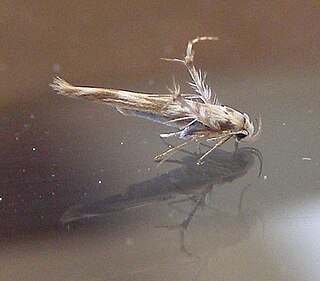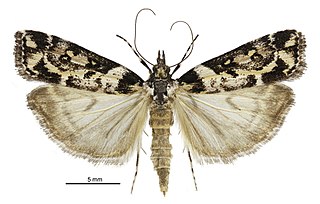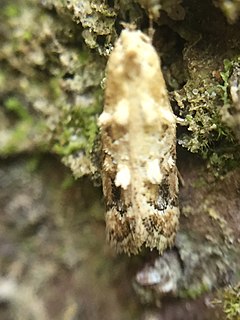
Palumbina is a genus of moths in the family Gelechiidae.

Eriocrania sangii is a moth of the family Eriocraniidae. It is found in Europe.

Eudonia diphtheralis is a species of moth in the family Crambidae. It is endemic to New Zealand.
Brenthia pleiadopa is a species of moth of the family Choreutidae first described by Edward Meyrick in 1921. It is found in Magude, Mozambique.

Cochylichroa atricapitana, the black-headed conch, is a moth of the family Tortricidae. It is found in China (Xinjiang) and the eastern Palearctic and most of Europe.
Hypatima ammonura is a moth in the family Gelechiidae. It was described by Edward Meyrick in 1921. It is found in Australia, where it has been recorded from Queensland.
Araeophylla spiladias is a species of moth in the family Gelechiidae. It was described by Edward Meyrick in 1921. It is found in Mozambique.
Telphusa objecta is a moth of the family Gelechiidae described by Edward Meyrick in 1921. It is found in Zimbabwe.
Scrobipalpa sibila is a moth in the family Gelechiidae. It was described by Edward Meyrick in 1921. It is found in Mozambique.
Ethirostoma semiacma is a moth in the family Gelechiidae. It was described by Edward Meyrick in 1914. It is found in Guyana.
Palumbina pylartis is a moth of the family Gelechiidae. It was described by Edward Meyrick in 1908. It is found in Assam, India.
Palumbina glaucitis is a moth of the family Gelechiidae. It was described by Edward Meyrick in 1907. It is found in southern India and Sri Lanka.
Palumbina nesoclera is a moth of the family Gelechiidae. It was described by Edward Meyrick in 1929. It is found in India's Andaman Islands.
Orphnolechia acridula is a moth of the family Depressariidae first described by Edward Meyrick in 1918. It is found in French Guiana.
Heteralcis palathodes is a moth in the family Lecithoceridae. It was described by Edward Meyrick in 1906. It is found in Sri Lanka.
Heteralcis tetraclina is a moth in the family Lecithoceridae. It was described by Edward Meyrick in 1906. It is found in Sri Lanka.
Epichostis antigama is a moth in the family Xyloryctidae. It was described by Edward Meyrick in 1908. It is found in southern India.
Pseudocentris is a monotypic moth genus in the family Depressariidae. Its only species, Pseudocentris testudinea, is found in Peru. Both the genus and species were first described by Edward Meyrick in 1921.
Stenoma stephanodes is a moth in the family Depressariidae. It was described by Edward Meyrick in 1931. It is found in French Guiana.

Trachypepla aspidephora is a species of moth in the family Oecophoridae. It is endemic to New Zealand and has been observed in the North and South Islands. Adults are on the wing from November to March and are attracted to light. The moths can be found resting on tree trunks where their colouration imitates lichens.




